Introduction
Internal organizational communication is defined as communication directed to the organization’s collaborator and its effectiveness is a vital factor for the achievement of objectives. Gómez and Benito (2014) comment that it can achieve important changes in the work culture of companies, such as determining appropriate identifiers of their reason for being, clearly defining their corporate mission and vision, achieving greater commitment from their staff and appropriate interrelationships with their audiences and environments; all in coherence with needs and demands of the globalized world, the markets and the region in particular.
The pandemic turned remote work into a massive social and labor experiment at international level, in which more than 50% of the working population can work remotely, and 80% of remote workers do it from their homes, according to a study conducted by the company Buffer (Suarez, 2020). In October 2020, a quarter of a million Peruvians will be working remotely (El Peruano, 2020).
In the survey conducted by Novella et al. (2019) called “Skills at Work Survey 2017-2018: Causes and Consequences of Skills Gaps in Peru”, sponsored by the Inter-American Development Bank [IDB], 89% of workers consider continuing and competent education important in their organization. Regarding the importance of new technologies in companies, 57% of the sample highlights the advanced service in networks and 43% artificial intelligence. Apart from that, in the survey of “Soft Skills in Peru: Situations and Opportunities”, 62% consider that communication is very important within an organization, 86% participants state that communication is very important (ISIL, 2018).
According to a UNESCO report (2020), due to the state of emergency, 185 countries were forced to temporarily close educational institutions to counteract the spread of the coronavirus. Many of these entities have had to adapt their teachers to work remotely in order to continue teaching in universities and colleges. Gallegos (2020) explains that workers have had to adapt their homes to remote work, buy technological equipment, pay for better Internet service and subsidize the increase in their electricity and water bills. Remote work has some disadvantages such as workers being distanced from their offices, work teams, bosses, managers, which in many cases generates poor communication and distancing. Hence, the general problem of this research is to answer the question: How is internal organizational communication in remote work in higher education institutions in times of the COVID-19 pandemic?
Various theories help to understand the subject of study. Internal communication is a set of messages and actions carried out consciously and voluntarily to relate in a good way among the members of the organization, through the use of means of communication that keep them informed, integrated and motivated to achieve organizational objectives (Andrade, 2005; Capriotti, 2009; La Torre-Torres et al., 2022). Organizational communication can make significant contributions to small, medium, and large companies in their process of adaptation to the new needs of internal and external markets. In addition, it contributes to business management to achieve the objectives set with all audiences, as well as to promote business development to articulate the actions of each of the areas or departments that make up the company (Gómez and Benito, 2014; Salazar-Rebaza et al, 2022; Pineda, 2020). Internal communication studies 7 dimensions: essential (sincerity, openness to dialogue, negotiation capacity); operative (opportunity, relationship capacity); strategic (physical contact, kindness, listening); valuational (honesty, responsibility, punctuality); motivational (motivation, training); learning (defense of interests, valuation of work, consideration of opinion); and motivational intelligence (problem solving, recognition of achievements) (Formanchuk, 2010).
Remote work in Peru contemplated in Emergency Decree No. 026-2020, due to the state of emergency caused by COVID-19 [Peru, Presidency of the Republic, 2020, Supreme Decree No. 010-2020-TR], is performed with the services provided by a worker through computer, telecommunications and analog equipment (Internet, telephony or others), as well as other means that allow performing the work; the worker is physically at home or in the place of domiciliary isolation (Presidencia de la República, 2020). The remote worker continues to obtain benefits such as remunerations, the nature of the labor relationship, among others, except those related to attending the work center such as mobility and food. In addition, it was established that remote work was mandatory for the risk group by age and clinical factors set in the technical document approved by Ministerial Resolution No. 084-2020-MINSA; in case it is not performed, the employer must receive a leave of absence with credit (Puntriano, 2020).
In remote work there are advantages such as: flexible hours, greater autonomy and responsibility, comfort, cost reduction, elimination of travel time, and disadvantages such as lack of work environment, social isolation, lack of inspiration, operating costs borne by the worker, fewer career opportunities, job insecurity (Cardozo and Bulcourf, 2020). The worker often rejects remote work due to social (reduced visibility in front of his face-to-face colleagues), organizational (being present at the workplace to perform), technological, financial and personal aspects, which do not benefit him (Mohalik et al., 2019). In turn, this new modality has brought with it the creation of new leadership, including digital leadership, which consists of directing staff interactions through new information and communication technologies (Cordova et al., 2022).
There are several precedents on internal organizational communication and remote work. Tapia (2020) developed a research study on remote work in non-urgent processes as a result of the outbreak of coronavirus (COVID-19) in Peru which is based on the search for the modernization of the administration of justice and the judicial office due to the pandemic; in this way, they seek to provide solutions for the continuity of processing of non-urgent processes with the purpose of implementing remote work for procedural unloading. Valenzuela et al. (2020) analyze how internal organizational communication is related to the satisfaction of employees and their superiors of the car dealership company of Piedras Negras Coahuila (in the era of technology), with this, achieving that workers reach the company’s objectives. On the other hand, Bedoya (2017) based his research on internal communication in educational institutions through a diagnostic tool; in this way, shows how teachers, managers and administrative staff communicate internally because they are responsible for the development and transformation of the institution.
Fardoun et al. (2020) conducted an exploratory study based on the main difficulties of educational institutions in Ibero-America and some strategies used in the teaching-learning processes, in which they analyze the problems found in teachers and teaching, and propose an evaluation model for contingency plans due to the pandemic. Papic (2020) bases his article on describing the means of internal organizational communication used by the team of managers and teachers, thereby generating knowledge that makes it possible to characterize the communicative practices in educational organizations and increase the cultural heritage in this area.
Muñoz et al. (2017) base their research on communication, culture and leadership for telework; in this way, it contributes to the personal, family and professional development of collaborators and positively impacts the environment and mobility in cities. Valero et al. (2019) propose a conceptual model that identifies two groups of practices: the methods of ideation and creation of products, and agile methodologies for the management of daily work, thereby achieving better coordination between professionals and teams. Papic (2019) describes the types of internal organizational communication that are applied between managers and faculty in the coordination of work, in which they conclude that managers prefer formal, top-down, horizontal and ascending communication to coordinate the faculty; these types of communication favor the coordination of the work of managers and faculty in the management processes of the educational organization.
The research is justified in this time of pandemic due to the coronavirus, since it analyzes how internal communication is executed in remote work in a situation of confinement in higher education entities, allowing a comparison between private and public entities. At first observation, situations of discomfort, stress and exhaustion are found, which cause deficiencies in their work performance.
The general objective of the research is to determine how internal organizational communication is carried out in remote work in higher education institutions in times of the COVID-19 pandemic. On the other hand, the general working hypothesis is: Organizational internal communication in remote work in higher education entities in times of the COVID-19 pandemic is performed with good negotiation skills, engaging in a good working relationship, in a friendly manner, in a timely manner, with responsibility and punctuality; but there is also little dialogue, absence of sincere communication, absence of attention in the dialogue established in meetings, little honesty and motivation, absence of training for the realization of virtual classes, absence of training for the use of virtual tools, absence of valuation of work performance, little consideration of the opinion, little knowledge to solve problems effectively and no recognition of achievements.
Methodology
The present research is quantitative; it uses the non-experimental design since it does not manipulate the data; it is cross-sectional because it collects data at an exact time and in this case the data correspond to the year 2021.
The population universe is constituted by 43 891 university teachers; according to the National Institute of Statistics and Informatics (INEI, 2019), there are 7 668 teachers in public universities and 36 223 teachers in private universities. Applying non-probabilistic and convenience sampling, a sample of 94 teachers was obtained who worked in the periods 2020-l and/or 2020-II, in public and private universities in Metropolitan Lima – Peru. The ages of the teachers ranged from 25 years old to 75 years old or older, of which 78.7% were men and 21.3% were women. The selection criteria were as follows: teachers who will work in public and private universities in Metropolitan Lima, Peru, and who were working in the periods 2020-l and/or 2020-2.
The data collection technique is the survey; the sample data were collected online through the Google Forms tool that was shared by email, WhatsApp, Facebook and Fan Page of the universities; due to the situation of the Covid19, it was not possible to conduct the survey in person at the educational institutions. The instrument is a 41-item questionnaire, in which the questions are divided into the 7 dimensions on which the research is based (essential with 5 items, operational with 6 items, strategic with 4 items, evaluative with 6 items, motivational with 6 items, learning with 6 items, emotional intelligence with 7 items), with Likert scale alternatives and 5 options as answers (5 = Strongly agree, 4 = Partially agree, 3 = Indifferent, 2 = Partially disagree, 1 = Strongly disagree). The survey also asked for opinions on the advantages and disadvantages of remote work in times of the pandemic, and 8 questions with demographic data requesting data such as gender, age, academic level, type of contract, academic area and university where you work. It should be noted that the survey was anonymous and confidential, as no teacher was asked for name, surname, ID number, e-mail address or any other identifying information. In addition, before starting the survey, a filter question was added so that only teachers working in the 2020-l and/or 2020-2 periods in public and private universities in Metropolitan Lima would answer the survey.
The instrument is based on the questionnaire of Silva’s (2018) research on internal organizational communication and organizational commitment in the administrative staff of a public university. In addition, the instrument is validated by applying Cronbach’s coefficient and by 5 experts; according to the theoretical approach of Palella and Martins (2006) who argue that expert judgment is a useful validation method, where the opinion of people with experience in the subject is received on the assessment of the instrument used. Data processing was carried out using Microsoft Office Excel to obtain statistical frequencies and percentages, which were presented in tables and figures describing the problematic situation posed.
Results
Quantitative Research
The profile of the respondents was a population of university teachers in Metropolitan Lima; the age range is between 25 and 65 years, with a majority participation of men of 78.50%. Similarly, the respondents hold bachelor’s, master’s and/or doctoral degrees; and 69.89% are part-time teachers.
Cronbach’s alpha
The resulting coefficient is 0.9694, which indicates that the reliability of the survey is high. This result was calculated thanks to the following data:
Table 1: Results of the scan

According to Formanchuk (2013), who defines internal communication in 7 dimensions (essential, operational, strategic, valuational, motivational, learning and intelligence), the results are presented according to the response of the interviewees, based on the dimensions.
Essential dimension
Table 2: Communication and adequate bargaining power between
 university authorities and teachers
university authorities and teachers
For the identification of the central tendency, the mean was calculated by adding the 93 valid data presented and then dividing this result by the total number of values. The resulting value is 4.1398, which allows us to describe the sample based on what was analyzed, this sample was represented by 5 as completely agree and 1 as completely disagree.
It was observed that the teachers consider that there is a good communication and negotiation capacity with the university authorities, since 40.90% agree with it and 39.80% completely agree, which allows us to point out that the majority presents a favorable tendency towards it.
Table 3: Openness to dialogue between university authorities and teachers

For the identification of the median, the median is calculated by sorting the numbers in ascending order and then locating the number in the middle. For this analysis, the resulting median is 4.
Another aspect to qualify was whether there was a good dialogue between university authorities and teachers, which is of vital importance to transmit the message of the university to the students. The majority, 83.80 %, consider that they agree with it, among this percentage are those who partially and totally agree.
Operational dimension
Table 4: Explanation of job functions, creation of identity among collaborators and appropriate identification of the right time to talk to teachers by the University

Similarly, the mode in this analysis was 5, which indicates that the most repeated rating in the questions asked to the respondents was that they totally agreed.
The majority percentage is present with 48 people totally agreeing that their superiors have correctly explained their job functions and that the university has allowed them to create a common sense of vision and identity among the collaborators. Similarly, 20.50 % indicated that they disagreed or were indifferent about it; although it is not a majority percentage within the results, the reason for their response should be investigated.
Table 5: Timely relationship between university authorities and teachers and the development of good interpersonal relationships
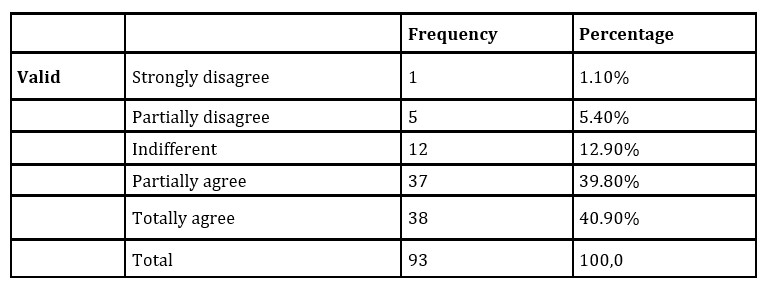
Communication plays a key role within any organization, since it is the basis for the correct transmission of the objectives to be achieved, as well as the ways in which they will be achieved. 80.70 % of the total number of teachers surveyed indicated that within their work centers there is a correct relationship between them and the university authorities. On the other hand, only one person totally disagrees with this.
Strategic dimension
Table 6: Existence of a correct communication between university authorities and teachers during their virtual meetings

The standard deviation indicates how far the score is from the mean; for the calculation of this the respective formula is applied, so the result in this case is 0.91594.
Due to the pandemic, the activities have had to be carried out online, which is a greater challenge for everyone, since it requires that certain factors are met to achieve success. In the same way as the previous results, the surveys provide us with favorable information regarding this, 86.10% agree that in their virtual meetings there is a correct communication between them and the respective authorities, as well as interest in the opinions, kindness and attention to the comments of all. On the other hand, only 3.30 % disagreed with this.
Value dimension
Table 7: Presence of honesty, responsibility and punctuality in the university authorities
The variance is calculated using a form and helps us to identify the variability of a data set. The result was 0.967.
In the surveys, three qualities of utmost importance for the execution of any activity have been highlighted. Therefore, 83.80 % agreed with it; within this result, 55 people totally agreed and 23 only agreed. In spite of the fact that the position in disagreement continues to be lower, 5.40 %, the indifferent result doubles it and shows us that the teachers are not able to define their decision and this is not a good indicator.
Table 8: Presence of honesty, responsibility and punctuality among teachers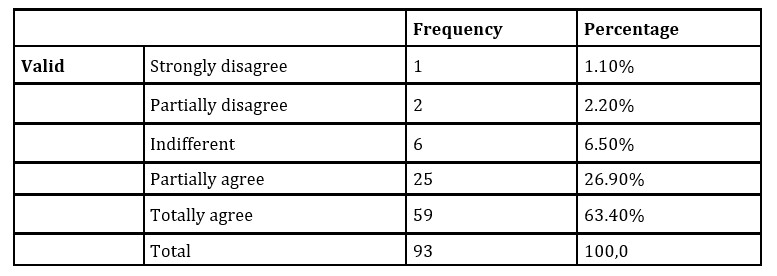 The mean in this case is 4.4946, which reflects that the average of the answers given by the respondents was positive, since this result is between partially and totally in agreement with what they were asked.
The mean in this case is 4.4946, which reflects that the average of the answers given by the respondents was positive, since this result is between partially and totally in agreement with what they were asked.
The next question to analyze was whether they considered that they were an example of honesty, responsibility and punctuality, and 90.30 % responded that they agreed with this, based on a self-evaluation in order to define their answer. Likewise, 9.70 % were indifferent or disagreed. As in the previous point, in spite of being a minority, it is still a fact to consider, since it is the teachers who deal directly with the students, who are expected to become professionals with ethics and morals.
Motivational dimension
Table 9: Results regarding whether the university provides virtual tools, motivation, solutions to technical problems, training and appreciation of the work of teachers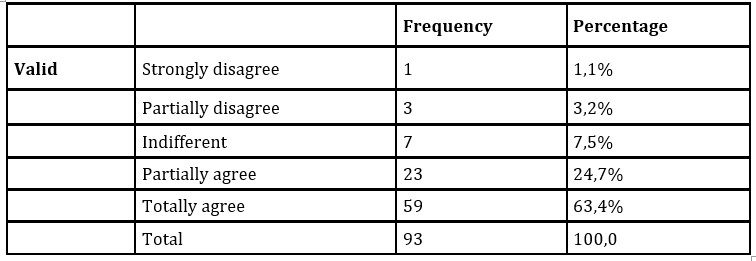
The mode for analysis is 5, that is, the most repeated response was “totally agree”. Due to this, it can be concluded that teachers do perceive that the university supports them with regard to technological issues.
Since the modality of work is online for the teachers, the universities are in charge of providing them with the necessary tools for the development of their activities, as well as solutions to technical problems, training, motivation and valuation of their work. Of the total, 88.10 % agreed that this is the case in their work center and 11.80 % were indifferent or disagreed. We can analyze that the favorable tendency continues to be maintained with a result higher than 80% since the first analysis.
Table 10: Shows whether the university authorities carry out an evaluation and follow-up of the work of the teachers, as well as the inclusion of their opinions in the decision-making process
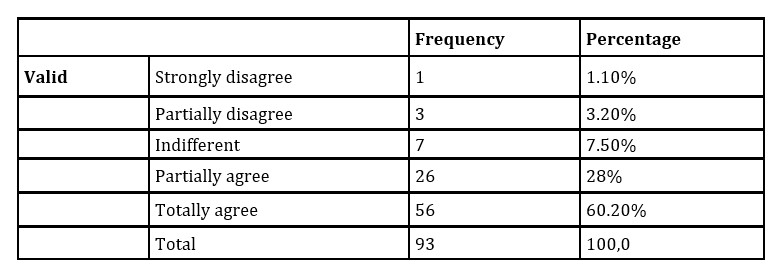 The resulting mean is 4.4301, which gives us information about the average value of the 93 data analyzed.
The resulting mean is 4.4301, which gives us information about the average value of the 93 data analyzed.
88.20 % of the teachers surveyed indicate that the authorities carry out a performance evaluation of the teachers, have a follow-up program for the fulfillment of the virtual classes and feel that their opinions, ideas and/or suggestions, are taken into account. The percentage of indifference and disagreement remains at 11.80%.
Table 11: The effectiveness of e-mail communication, the existence of opportunities to present their
ideas and the cohesion of groups to carry out the work
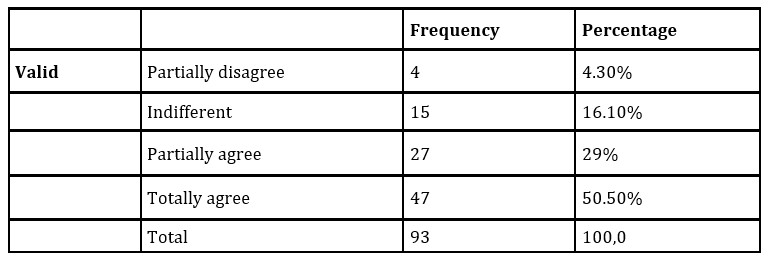
As in the previous cases, the mode in this analysis is 5, which, once again, shows that, for the most part, the teachers are in total agreement with what was asked about the effectiveness of the communication that exists in the university.
Of the total number of respondents, 79.50 % agree with respect to effective communication by e-mail; the existence of being able to express their ideas and the cohesion of groups to be able to carry out their work is the first data that represents a decrease in this option with respect to the results obtained previously. On the other hand, 20.40 % are indifferent or partially disagree with it and it is the highest figure with respect to such opinions, which makes us notice a certain variation of opinions, due to the fact that, in previous tables, the results had noted that there was a correct communication and listening about their opinions.
Learning dimension
Table 12: Regarding the performance evaluation of teachers and the follow-up program for the fulfillment
of the virtual classes by university authorities
The mode in this analysis is 5, which, once again, shows that teachers consider that their performance is correctly evaluated and that their classes are being supervised.
Of the total number of respondents, 68.80% totally agree that the university authorities are carrying out a correct evaluation of their performance as teachers and that the university has also proposed a program that allows them to follow up on the classes they teach. On the other hand, 10.90% were indifferent or partially disagreed with the above mentioned; in spite of being a minority, it makes us reflect on this result, since it is of vital importance the follow-up of the activities so that the universities can offer an adequate education service.
Table 13: Regarding whether email is an effective form of communication and whether teachers’
opinions are taken into consideration in decision making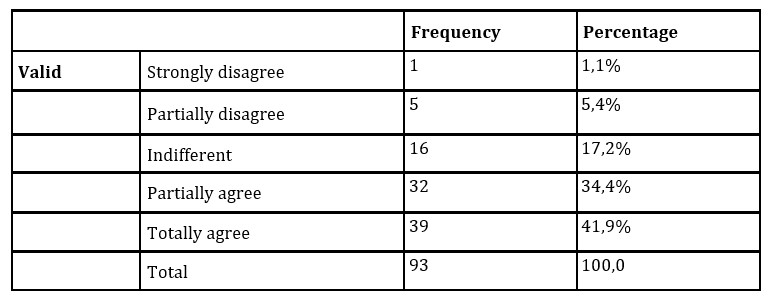
The mode is 5, which confirms that the teachers do consider e-mail to be a correct form of communication and that they do feel that their opinions are taken into account when the university decides on certain actions.
Of the total number of respondents, 41.90% totally agree; although it is a considerable percentage, it is not higher than 50%, so we have to analyze it together with another item, partially agree, the sum of both gives us 76.3% of acceptance, that is, teachers feel part of the decision-making process in general, but not in its totality. On the other hand, the remaining 23.70% do not have the same opinion, which allows us to analyze the possible solutions that should be implemented to have an efficient communication and to analyze the situation from different perspectives when making decisions.
Table 14: Regarding whether the university authorities provide teachers with opportunities to share their knowledge and whether there is adequate group cohesion to carry out the work

The mode is 5, which shows that the teachers consider that the university does allow them to expose their ideas and that there is a good cohesion of groups to carry out the activities.
Of the total number of respondents, 44.10% totally agree with the statement, which allows us to analyze that even though it is not as high a percentage as the previous ones, in general terms, they do agree that the authorities allow them to present their ideas.
Motivational intelligence dimension
Table 15: Regarding whether university authorities solve problems in the most appropriate way, recognize teachers’ achievements and give them the reason when they are right
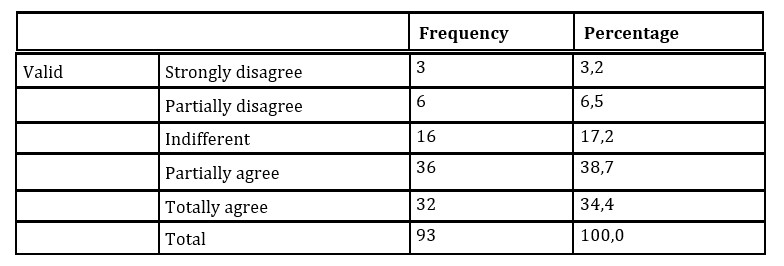
The mode is 4, which shows that they partially agree with the actions taken by university authorities with respect to them.
Within the “agree” group, 73.1% of the total number of respondents are found, an important figure that allows us to know that they accept that the authorities do solve problems adequately, recognize their achievements and highlight them for that reason, as well as accept when they are right. The remaining percentage is lower, but is nonetheless important, given that it would be necessary to analyze the reason for this response and what actions could be taken in response to it.
Table 16: Regarding whether teachers recognize when the university acts in the right way, congratulate
the achievements of their colleagues and solve their problems in the right way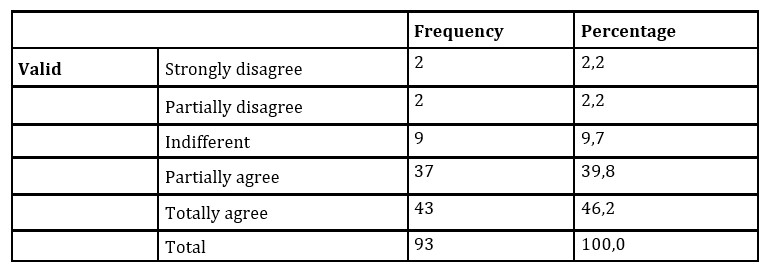
The mode is 5, which shows that the teachers consider that they are fulfilling their duties well at the moment of recognizing the achievements of their colleagues and the university, as well as solving their problems efficiently.
With respect to the previous graph, in this case the highest percentage is in total agreement with the above-mentioned statement and presents 86% of positive results, which shows that the teachers feel that they give more than the university authorities, since the questions were the same.
Qualitative Research
Due to the restrictions of the pandemic, the interviews with the administrative coordinators were conducted virtually. Additionally, a table was prepared showing the division of coordinators between private and public educational entities, at the discretion of the collaborators.
Table 17: Number of coordinators of private and public entities

Essential internal organizational communication
Within the educational entities of Metropolitan Lima, there is adequate communication between coordinators and teachers, despite the fact that they do not work face-to-face. Communication between them occurred virtually through different channels such as e-mails, telephone calls, communication platforms such as Google Meets, Team and Zoom, as mentioned by the coordinator of the public educational entity (CEEPB):
“…Communication was given by Zoom to carry out formative meetings with a greater number of teachers, and by WhatsApp for a daily communication, it was a good communication, there was always respect among all…”
Operational organizational internal communication
An effective and empathetic communication is found between the coordinators and the teachers of the educational entities, by receiving an immediate response and resolution of their doubts by different means. On the other hand, some actions were found that did not make it such an effective communication, as the coordinator of the private educational entity (CEEPV) comments:
“…There was a lack of participation of teachers, in many of the meetings there was an absence of comments on their part, mostly we coordinators talked and they listened, but I consider that little by little it is improving to obtain a better communication…”
Strategic internal organizational communication
Internal communication between coordinators and teachers is essential for a good work performance, no matter how routine it may be, because if it is not properly coordinated, the guidelines are not clear and the work is not impeccable. According to the coordinator of the private educational entity (CEEPV):
“…Internal communication allows you to get to know your team better, coordinate activities in detail and anticipate situations…”
In addition, the coordinator of the public educational entity (CEEPB) complements:
“…You must have a purpose, from the institutional set in the objectives, in this way to be able to meet the expectations of the students to provide a good service…”
Valuative organizational internal communication
Within public and private entities, internal communication is mostly shown in a responsible, honest and punctual manner, values that characterize teachers and coordinators so that they are better every day and feel proud of their actions. However, some of these entities need to improve some actions to achieve internal communication with these values, as indicated by the coordinator of the private educational entity (CEEPV):
“…It is improving progressively, at the beginning it was a hard change that affected all of us in different areas, above all to reorganize ourselves. It was a hard change that affected all of us in different areas, especially reorganizing ourselves again; we are working to polish it and give good results…”
Motivational internal organizational communication
The different universities supported the teachers in solving any inconvenience presented, as well as with additional activities (training for proper communication with students, training for a better use of platforms, etc.), in order to be able to better manage the services remotely. Likewise, the university recognizes the achievements that teachers have made during the cycle, serving as a great motivation for them for the effort made during the pandemic. According to the coordinator of the private educational entity (CEEPV) on how the teachers’ achievements were recognized:
“…At the faculty level, diplomas were awarded to those who came out first in the ESA surveys and they were congratulated in front of everyone in a virtual meeting, that is called the “teachers’ excellence” award. Also, awards were given to teachers who won in entrepreneurial contests in Expoinova, teachers who have made scientific publications and book publications, teachers who have won master’s degrees or have done doctorates, giving them diplomas and monetary bonuses. This was done at the end of the previous cycle, in November. In December, the “maestra vida” award was held at the level of all the branches of the Universidad Privada del Norte…”
Organizational internal learning communication
Within the educational entities, teachers received training on the use of university platforms, so that they can carry out their classes, upload students’ grades and perform different evaluations correctly; and other external platforms (such as Zoom, Team, among others), in which they can hold meetings between teachers and/or coordinators where they are informed about internal communication, the communication system, their duties and other important issues. Most of these trainings were conducted remotely and in a few cases in person, in which there were incidents with the attendance of the personnel, according to the coordinator of the public educational entity (CEEPB):
“…They trained in person and few collaborators went, they did not give importance to it, currently they regret not having attended these trainings of essential tools that serve us until now and who knows until when more…”
Organizational internal communication of motivational intelligence
It can be concluded that the educational entities are willing to listen and improve, considering the opinion of the teachers, valuing the effort made, allowing them to express their ideas and suggestions. On the other hand, it is examined that there has not been a complete consideration of opinion on the part of the university, as the coordinator of the private educational entity (CEEPV) comments:
“…Prior to the quarantine there were many ideas and antecedents in reference to other countries with opinions on how we could improve in order to handle the situation and anticipate how we would look facing it, perhaps, if the university had analyzed these factors things would have been handled differently being more beneficial for teachers, administrative and students…”
Discussion
This study shows that teachers have a fluid, timely, and respectful dialogue at all times, developing an empathetic relationship with their co-workers (reinforcing them for their achievements), with adequate negotiation skills with university authorities and better control for the resolution of problems that may arise daily at the university. On some occasions, they have not been as expected to generate participation and initiative of teachers within the virtual meetings held for the coordination of activities. On the part of the authorities, in the meetings they have shown interest in the ideas expressed by the teachers and many times they have been taken into account, but not in their totality; there are some occasions in which they do not feel part of the decision making about the teaching method that the collaborators of a company assume.
The corporate identity of a company’s employees becomes such an important pillar that it shows in the results of their performance. According to this, it is evaluated that a fundamental point is that the educational entities have the main organizational values such as honesty, responsibility and punctuality that characterize not only the entity but also the teachers in order to obtain a better trust from the students, even so, there are entities that do not have these values. On the other hand, most of the workers surveyed have a correct knowledge of their job functions, which leads them to perform in a better way with the clear mission and vision of the educational entity to which they belong, but it is considered a risk that there is a percentage of educational entities that do not give the correct knowledge in such an important area.
Adequate internal communication leads to a more pleasant work environment for teachers, allowing them to get to know their work team better in order to perform better in their activities, thus providing a good service that meets the students’ expectations. Similarly, it is highlighted that the personal motivation that some universities provided to their collaborators by recognizing their achievements during the academic cycle, such as winning entrepreneurial contests, scientific or book publications, or earning a master’s degree or doctorate, with which they obtained diplomas and monetary bonuses, is also noteworthy.
In relation to the management for a good work performance, a series of actions were analyzed that were carried out by the different universities so that the professors fulfill the goals in the correct way, understanding in detail what should be done. It starts with virtual tools for good management and training of these tools so that they have a basic knowledge or improve it, as well as training for the management of the virtual platform of their university, and training for good management of communication with students for the new remote mode. Also, to monitor the performance of teachers and compliance with virtual classes, and finally, a support team was provided for any technical problems that may arise.
It should be noted that 88.10% of the teachers surveyed agree that they were provided with the appropriate tools, training and problem solving, which leads to the conclusion that they are satisfied in this aspect; in the study by De Los Heros et al. (2020), they agree that most university teachers are satisfied or very satisfied working in remote mode. On the other hand, these results do not coincide with Huamán et al. (2021) who indicate that digital competencies should be strengthened since teachers did not have the necessary technological tools to provide a correct educational service; coinciding with the article by Fardoun et al. (2020) where almost 40% of teachers consider that there is a lack of digital platforms and technological resources.
Analyzing the results of the operational dimension, we find teachers in disagreement and indifferent regarding whether they feel identified with the educational entities to which they belong, affecting the entity since the message it wants to express does not reach the students as a final result; this agrees with the study of Bedoya (2017), in which he explains that educational institutions need to reaffirm their corporate identity and build a new vision, considering communication of utmost importance to be able to correctly address their internal processes. Likewise, the research of Gómez and Benito (2014) indicates that the corporate culture must reach all areas equally to achieve a new approach of belonging to the values of the company, which complements the research of Papic (2019) where he agrees that having a corporate identity in workers creates a positive working environment and a more effective professional performance individually, group and collective, thereby achieving the fulfillment of the goals of educational quality.
At the same time, there is a small percentage of teachers who do not have a correct knowledge of their job functions, which is considered as a factor that can affect job performance; this agrees with the article by Pineda (2020) where he comments that a weakness of internal communication is that workers do not have a clear knowledge of the objectives and goals of the company. In addition, the theory of Iñaguazo’s article (2020) considers that each educational authority must provide the information required for the coordination and performance of the work, as well as obtain a better performance as a teacher.
On the other hand, more than 80% of the teachers consider that a correct communication was executed in the virtual meetings where they were informed about the work, duties to be done and the communicative system; this coincides with the research of Papic (2020) in which he points out that the virtual meetings were held continuously and served to transmit information and contribute to the cultural union between managers and teachers.
The existence of motivation on the part of the university authorities is also confirmed, since they recognize and congratulate the achievements of the teachers, which leads to a better work performance as a result. This is related to the article by Muñoz et al. (2017) where personal motivation is concluded to equal opportunities, assumption of work responsibilities, recognition among colleagues, evolution of their performance, leadership development and most importantly personal growth. Next, with the article by Viñarás et al. (2020), in which they mention that, to generate motivation and trust, interpersonal communication is important to provide clear and understandable information to all employees of the company, thus achieving an adequate working environment and a reduction of internal conflicts.
Regarding the process of collecting the surveys obtained, more time was required than expected due to the fact that the dissemination was done virtually, through social networks, and not in person, which would have allowed obtaining the data more quickly. It is recommended to evaluate internal communication in higher education institutions taking into account a broader sample that includes universities in other regions of Peru, which would allow improving university management and having an evaluation tool for teamwork and leadership.
Conclusion
According to the results and discussion of this research, it was determined that internal organizational communication in most of the higher education institutions was carried out in an adequate manner among teachers, with co-workers and university authorities, establishing an empathetic, timely, honest and respectful communication, despite not being face to face. Even so, it has not been perfect, because there are several important factors that make it difficult to have a better organizational communication, which can be improved by showing where it is failing and creating new mechanisms for such communication to improve and teachers can transmit and meet the desired goals of the university.
The following is the conclusion: 1) the communication, despite not being carried out in person, was carried out with a good dialogue between university authorities and teachers, making the communication channel through virtual platforms; 2) the communication was in a timely manner, creating a good working relationship between managers and teachers; 3) the communication was given with much respect, showing kindness at all times, but with lack of attention in the dialogue engaged; 4) the communication is not always engaged with honesty, responsibility and punctuality; 5) there was great motivation on the part of the university towards the teachers through recognition in virtual meetings and events, as well as adequate training for the use of virtual tools and remote teaching; 6) the communication valued the performance of the teachers, but did not fully consider the opinion of each one of them; and finally, 7) the university authorities solve problems effectively, recognize the achievements of the teachers through diplomas, public recognition and awards, and almost always recognize when the teachers are right.
References
- Andrade, H. (2005), Part One: Concept and model of internal organizational communication, Internal organizational communication: process, discipline and technique, Netbiblo, Gesbiblo, ISBN 84-9745-100-7, Spain.
- Bedoya, S. (2017), ‘Internal communication in official educational institutions in the city of Montería, Colombia: The Case of the Cristóbal Colón Educational Institution’, https://doi.org/4185/cac116edicion2, Latin Journal of Social Communication, pp 1782-1794.
- Capriotti, P. (2010), ‘Corporate branding. Strategic management of corporate identity’, Communication Journal, ISSN 0120-1166, (27), 15-22.
- Cardozo, N. and Bulcourf, P. (2020), ‘Remote work in Latin America: A comparative analysis of advances in public administrations’, INAP Notebooks (CUINAP), ISSN 2683-9644, 1(32).
- Cordova-Buiza, F., Aguirre-Parra, P., Garcia-Jimenez, M., and Martinez-Torres, D. (2022), ‘Virtual leadership as a development opportunity in business context’, https://doi:10.21511/ppm.20(2).2022.20, Problems and Perspectives in Management, 20(2), 248-259.
- De Los Heros, M., Murillo, S., and Solana, N. (2020), ‘Job satisfaction in times of pandemic: the case of university teachers in the health area’, Caribbean Journal of Economics, ISSN 2145-9363, (26), 1-21.
- El Peruano (2020), ‘They prepare an initiative to expand remote work’, El Peruano. [Online], [Accessed June 22, 2022], https://elperuano.pe/.
- Fardoun, H., Yousef, M., González-González, C., and Collazos, C. (2020), ‘Exploratory study in Ibero-America on teaching-learning processes and evaluation proposal in times of pandemic’, Education in the Knowledge Society, 21, 17, https://doi.org/10.14201 /eks.23437
- Formanchuk, A. (2010), Internal communication 2.0: a cultural challenge, Buenos Aires: Edición Formanchuk & Asociados, 1st ed., Argentina.
- Gallegos, J. (2020), ‘Does remote work benefit or harm workers?’, La República. [Online], [Accessed August 15, 2022], https://larepublica.pe/
- Gómez Nieto, B. and Benito Vielba, C. (2014), ‘The present of organizational communication in Spanish SMEs’, Reason and Word, ISSN: 1605-4806, pp 18(86).
- Huamán-Ramos, L., Torres-Inga, L., Amancio-Anzuhueldo, A., and Sánchez-Díaz, S. (2021), ‘Remote education and teaching performance in educational institutions in Huancavelica in times of COVID-19’, University Notes, 11(3), 45-59, https://doi.org/10.17162/au.v11i3.692
- INEI (2017), ‘Teachers in public universities, 2011-2017’, National Institute of Statistics and Informatics. [Online], [Accessed August 07, 2022], https://m.inei.gob.pe/
- Iñaguazo, H. (2020), ‘The relationship between internal communication and the work environment in the teachers of the San Joaquín educational unit, of the Cumbe parish, in the period 2018’, Science and Education-Scientific Journal, 1(2), 6-17.¿, https://doi.org/10.48169/ Ecuatesis/0102202007
- ISIL (2018), ‘Study of soft skills in Peru: situation and opportunities’, San Ignacio de Loyola Institute. [Online], [Accessed July 18, 2022], http://www.isil.edu.pe/
- Mohalik, S., Westerlund, M., Rajala, R., and Timonen, H. (2019), ‘Increasing the adoption of teleworking in the public sector’, In ISPIM Conference Proceedings, The International Society for Professional Innovation Management (ISPIM), pp. 1-16.
- Muñoz-Zapata, D., Pabón-Montealegre, M., and Valencia-Ayala, B. (2017), ‘Organizational communication around telework’, Luciérnaga-Communication Journal, ISSN-e 2027-1557, pp 9(18), 61-71.
- Novella, R., Alvarado, A., Rosas, D., and González, C. (2019), ‘Skills to Work Survey (ENHAT) 2017-2018: Causes and consequences of the skills gap in Peru’, Labor Markets and Social Security Division, Inter-American Development Bank, IDB-TN-1652.
- La Torre-Torres, M. T., Pando-Medina, Z. M., Aragon-Ortega, P. M., & Cordova-Buiza, F. (2022). ‘Administrative management and work performance in hardware and construction SMEs: The case of Justiniano Soto Villanueva S.R.L., Peru’, IBIMA Business Review, 2022. https://doi.org/10.5171/2022.497769
- Palella, S. and Martins, F. (2012), Methodology of quantitative research, Fedupel, Caracas, Venezuela.
- Papic-Domínguez, K. (2019), ‘The types of internal organizational communication in municipal educational establishments in Chile’, Educational Research Notebooks, ISSN 1688-9304, pp 10(1), 63-83.
- Papic-Domínguez, K. (2020), ‘Internal organizational communication media in public schools’, Chile, Alteridad, pp 15(2), 241-255, https://doi.org/10.17163/alt.v15n2.2020.08
- Pineda-Henao, A. (2020), ‘Organizational communication in business management: challenges and opportunities in the digital scenario’, GEON Journal: Management-Organization-Business, ISSN-e 2346-3910, 7(1), 9-25.
- Presidencia de la República (2020), Supreme Decree No. 010-2020-TR, Supreme Decree that develops provisions for the Private Sector, on remote work foreseen in Emergency Decree No. 026-2020, Emergency Decree that establishes exceptional and temporary measures to prevent the spread of COVID-19 pp 12.
- Puntriano Rosas, C. (2020), ‘Complementary provisions on remote work’, The law. [Online], [Accessed July 01, 2022], https://laley.pe/
- Salazar-Rebaza, C., Zegarra-Alva, M., & Cordova-Buiza, F. (2022). ‘Management and leadership in university education: Approaches and perspectives’, Problems and Perspectives in Management, 20(3), 130-141. https://doi.org/10.21511/ppm.20(3).2022.11
- Silva Aroni, H. (2018), ‘Internal organizational communication and organizational commitment in the administrative staff of a public university 2017’, Universidad César Vallejo Repository. https://hdl.handle.net/20.500.12692/15898
- Suarez, C. (2020), ‘Conference on remote work: repeople Conference 2020’, ICT Economy. [Online], [Accessed June 28, 2022], https://economiatic.com/conferencia-trabajo-remoto/
- Tapia-Coba, F. (2020), ‘Remote work in non-urgent processes as a consequence of the coronavirus outbreak (COVID-19) in Peru and its continued application’, Official Journal of the Judicial Branch. Research Organ of the Supreme Court of Justice of the Republic of Peru, pp 11(13), 439-458, https://doi.org/10.35292/ropj.v11i13.53
- UNESCO (2020), ‘Education: From disruption to recovery, United Nations Educational’, Scientific and Cultural Organization. [Online], [Accessed August 10, 2022], https://bit.ly/3evM4sL
- Valenzuela, N., Martínez, C., Sánchez, V., and Briones, C. (2020), ‘Internal organizational communication and its relationship with employee satisfaction in a car dealership company in Piedras Negras Coahuila’, https://doi.org/10.22579/23463910.206, GEON Journal (Management, Organizations and Business), pp 7(1) 129-141.
- Valero-Pastor, J., Carvajal-Prieto, M., and García-Avilés, J. (2019), ‘Workflows for post-industrial journalism: methods and programs for a more agile and transversal organizational communication’, Information Professional, 28(5), https://doi.org/10.3145/epi.2019.sep.14
- Viñarás, A., Gonzávlez, J., and Rincón, S. (2020), ‘Interpersonal Communication and Internal Communication in companies: an analysis from the profession and the University’, Communication and Man, (16), 335-354, https://doi.org/10.32466/eufv-cyh.2020.16.607.335-354.



















